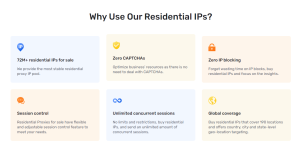✅1. Anonymization of network requests
Scenario: When a robot needs to access network resources (such as APIs), using a proxy can hide the robot's real IP address, thereby protecting its privacy.
Application: For example, web crawler robots use proxies to avoid having their IP addresses blocked by the target website.
✅2. Bypassing geographic restrictions
Scenario: Some websites or services restrict access to specific regions. Proxies can enable robots to disguise themselves as users from different regions to access restricted content.
Application: For example, content crawling robots can use proxies to access content that is limited to certain countries or regions.
✅3. Load balancing and request distribution
Scenario: Load balancing through proxy servers can distribute network requests to multiple proxy servers, thereby improving request processing capabilities.
Application: For example, large data crawling robots can use multiple proxy servers to disperse requests to avoid excessive load on a single server.
✅4. Improve request success rate
Scenario: When the target website restricts frequent requests, using different proxies can increase the success rate of requests.
Application: For example, some websites may restrict requests from the same IP, and using proxies can reduce the risk of being blocked.
✅5. Simulate user behavior
Scenario: Sometimes it is necessary to simulate the behavior of different users to test or crawl data. Through proxies, robots can disguise themselves as multiple different users.
Application: For example, automated testing robots can use proxies to simulate access behaviors from different users.
✅6. Monitoring and analysis
Scenario: Proxies can be used to monitor and analyze network traffic to obtain data about robot behavior.
Application: For example, data collected using proxies can be used to analyze and optimize the performance and behavior of robots.

Contact us for a better price!
Skype account:
Join conversation
WhatsApp account:
ProxyLite-Dorothy
Official Website:
https://www.proxylite.com/?keyword=Apri
Scenario: When a robot needs to access network resources (such as APIs), using a proxy can hide the robot's real IP address, thereby protecting its privacy.
Application: For example, web crawler robots use proxies to avoid having their IP addresses blocked by the target website.
✅2. Bypassing geographic restrictions
Scenario: Some websites or services restrict access to specific regions. Proxies can enable robots to disguise themselves as users from different regions to access restricted content.
Application: For example, content crawling robots can use proxies to access content that is limited to certain countries or regions.
✅3. Load balancing and request distribution
Scenario: Load balancing through proxy servers can distribute network requests to multiple proxy servers, thereby improving request processing capabilities.
Application: For example, large data crawling robots can use multiple proxy servers to disperse requests to avoid excessive load on a single server.
✅4. Improve request success rate
Scenario: When the target website restricts frequent requests, using different proxies can increase the success rate of requests.
Application: For example, some websites may restrict requests from the same IP, and using proxies can reduce the risk of being blocked.
✅5. Simulate user behavior
Scenario: Sometimes it is necessary to simulate the behavior of different users to test or crawl data. Through proxies, robots can disguise themselves as multiple different users.
Application: For example, automated testing robots can use proxies to simulate access behaviors from different users.
✅6. Monitoring and analysis
Scenario: Proxies can be used to monitor and analyze network traffic to obtain data about robot behavior.
Application: For example, data collected using proxies can be used to analyze and optimize the performance and behavior of robots.

Contact us for a better price!
Skype account:
Join conversation
WhatsApp account:
ProxyLite-Dorothy
Official Website:
https://www.proxylite.com/?keyword=Apri